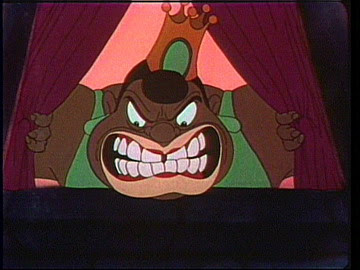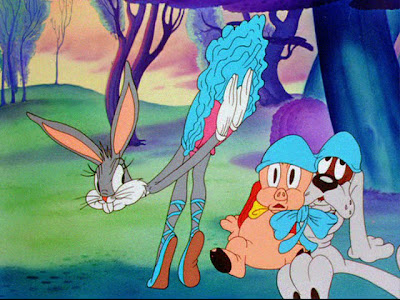
In the late 30s and early 40s, Tex Avery had a powerhouse animation crew that any director should die to have. He directed Bob McKimson, considered at the time Warner's top animator, Irv Spence for awhile and Rod Scribner, who no one had yet figured out was a total genius.
Tex had the #1 unit at Warner's but didn't really take advantage of them. The style he developed was a style of sarcastic jokes told with stand up comedy timing and delivery. This in itself was fresh and new for animation, a real innovation-especially for the west coast.
If you watch his Warner's cartoons the animation of course is great technically, but it isn't anywhere near as visual or exaggerated as what he would do a few years later at MGM. His animators seem uncast, interchangeable, because what he wanted from the animation was to get from one joke to the next smoothly and with live action comedy timing. The animators would inject some of their own styles into the scenes, as long as it didn't interfere with the joke.
Scribner's scenes are very solid and unless you are a fanatic like me, you would have a tough time telling the difference between his animation and McKimson's in Avery's cartoons. He started breaking out during the last couple years of Avery's direction.

Scribner's animation at the time actually feels a bit claustrophobic. It looks like the characters are filled with pent up energy. Their gestures now and then stretch out but are quickly pushed back as if there is an invisible force field surrounding them and stopping them from completing their motions.

 Clampett took over Avery's unit in 1941 and the cartoons that the same animators were doing changed quickly. Clampett had already been directing for 5 years with the "junior unit", the younger "less experienced animators" as Clampett referred to them.
Clampett took over Avery's unit in 1941 and the cartoons that the same animators were doing changed quickly. Clampett had already been directing for 5 years with the "junior unit", the younger "less experienced animators" as Clampett referred to them.Even so, the most energetic and experimental animation happening at Warner's happened in the black and white "junior" unit.
http://johnkstuff.blogspot.com/2007/05/pinch-and-outrage-bob-clampett.html
Chuck Jones and Bobe Cannon did some really wacky and expressive animation for him and then so did John Carey, Vive Risto, Izzy Ellis and a few other animators who are not as well known to history.
Bob told me that during the black and white period, he would have certain ideas he wanted to animate that he decided not to do, just because he didn't think his animators were yet skilled enough to pull them off.
After a short period of finishing some of Tex's cartoons and getting used to his new crew, his cartoons just exploded with imagination and most of all - a new energetic style of movement.

Eddie, Milt and I pestered Clampett for stories about all the animators all the time when we knew him and we would ask the most about Scribner. How did he get that crazy loose style?
George Lichty
Bob said Scribner came to him early on and asked if he could try a new looser style of animation - inspired by the loose finish of one of his favorite comic strip artists, George Lichty.


MORE GREAT LICHTY HERE!
http://www.animationarchive.org/2007/07/comics-george-lichty-grin-and-bear-it.htmlLichty was one of my favorite cartoonists when I was a kid so this story really interested me.
Lichty is great for a number of reasons. He was an extremely skilled technical artist who happens to draw cartoons. His compositions are great.
 He draws difficult and interesting perspectives in his cartoon panels. He can organize and compose crowd scenes.
He draws difficult and interesting perspectives in his cartoon panels. He can organize and compose crowd scenes.He has a very hard bitten street-smart sarcastic outlook of life which I, as a hard-bitten sarcastic 8 year old kid really took to.
But what Scribner was alluding to in Lichty's work was the finish. The brush lines are very loose, organic and fast. To the untrained non-artist's eye it might even look sloppy. A non artist won't see the great solid drawings underneath the superficially loose finished line work.

Check out the beautiful natural poses of the girls in the panel on the left.
Looney Tunes morph from the McKimson Style to the Clampett style
TheWarner Bros. cartoon drawing-animation style was basically Bob McKimson's making.
 Very very tight, solid and careful and volumetric. Less squashy and stretchy than Disney's. More weight and power. Conservative. Earthbound. The rest of the Warner's animation staff strove to emulate McKimson's skill-but didn't think to leave out the conservatism.
Very very tight, solid and careful and volumetric. Less squashy and stretchy than Disney's. More weight and power. Conservative. Earthbound. The rest of the Warner's animation staff strove to emulate McKimson's skill-but didn't think to leave out the conservatism. Scribner wanted to break through the safe logical membrane that the Warner's house style confined him in.
Scribner wanted to break through the safe logical membrane that the Warner's house style confined him in.Clampett was all for it. He was already experimenting and wanted more and more life and energy in his characters. He was already able to get more of that from his animators than other directors could, but here at last was a kindred soul that didn't need to be pushed to let go.
BEFORE LICHTY


 He gave Scribner the go-ahead to try out his Lichty looseness and he got this:
He gave Scribner the go-ahead to try out his Lichty looseness and he got this:
 The combination of Scribner's new breakthrough animation with Clampett's understanding of personality and his wildly inventive direction cemented the revolution of Warner's against Disney's. Scribner and Clampett not influenced the other animators in their unit, but also the rest of the studio - many against their wills. Friz hated what was happening but got swept along in the inexorable gushing current.
The combination of Scribner's new breakthrough animation with Clampett's understanding of personality and his wildly inventive direction cemented the revolution of Warner's against Disney's. Scribner and Clampett not influenced the other animators in their unit, but also the rest of the studio - many against their wills. Friz hated what was happening but got swept along in the inexorable gushing current.Warner's was no longer a cheap, less animated imitation of Disney. It was a force that everyone else now had to scramble not only to catch up to, but to even understand. To this day, not a lot of people realize what an explosion of creativity and power those few years in our history were.
I wonder if the animators knew at the time how big this revolution was. I get the feeling they really didn't and I'll tell you why in a later post.
SCRIBNER DOES AVERY - 1940



 Interesting side note: After Clampett abandoned Warner Bros. in 1946, McKimson shoved Scribner back into a smothering force field again and when you watch Scribner's characters twitch and agitate, it looks like they are trying to bust their limbs through but never quite can.
Interesting side note: After Clampett abandoned Warner Bros. in 1946, McKimson shoved Scribner back into a smothering force field again and when you watch Scribner's characters twitch and agitate, it looks like they are trying to bust their limbs through but never quite can.MORAL OF THE STORY: GET SOME INFLUENCES FROM OTHER FORMS OF CARTOONS! NOT JUST DISNEY
Let's have animation evolve again!
http://johnkstuff.blogspot.com/2006/09/importance-of-having-lot-of-influences.html




